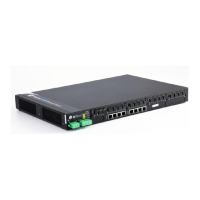CHAPTER 13: RAPID SPANNING TREE PROTOCOL RAPID SPANNING TREE PROTOCOL
MULTILINK ML3000 ETHERNET COMMUNICATIONS SWITCH – INSTRUCTION MANUAL 13–5
• Bridge Hello Time: When the switch is the root device, this is the time between
messages being transmitted. The value is from 1 to 10 seconds with a default of 2.
• Bridge Max Age: This is the maximum time a message with STP information is
allowed by the switch before the switch discards the information and updates the
address table again. Values range from 6 to 40 seconds with a default value of 20.
• Root Port: Indicates the port number, which is elected as the root port of the
switch. A root port of "0" indicates STP is disabled.
• Root Path Cost: A path cost is assigned to individual ports for the switch to
determine which ports are the forwarding points. A higher cost means more loops;
a lower cost means fewer loops. More loops equal more traffic and a tree which
takes a long time to converge, resulting in a slower system.
• Designated Root: Shows the MAC address of the bridge in the network elected or
designated as the root bridge.
• Designated Root Priority: Shows the designated root bridge's priority. The default
value is 0.
• Root Bridge Forward Delay: Indicates the designated root bridge's forward delay.
This is the time the switch waits before it switches from the listening to the
forwarding state. This value can be set between 4 to 30 seconds, with a default of
15.
• Root Bridge Hello Time: Indicates the designated root bridge's hello time. Hello
information is sent out every 2 seconds.
• Root Bridge Max Age: Indicates the designated root bridge's maximum age, after
which it discards the information as being old and receives new updates.
• Topology Change Count: Since the last reboot, the number of times the topology
has changed. Use this in conjunction with "show uptime" to find the frequency of
the topology changes.
• Time Since topology Change: The number of seconds since the last topology
change.

